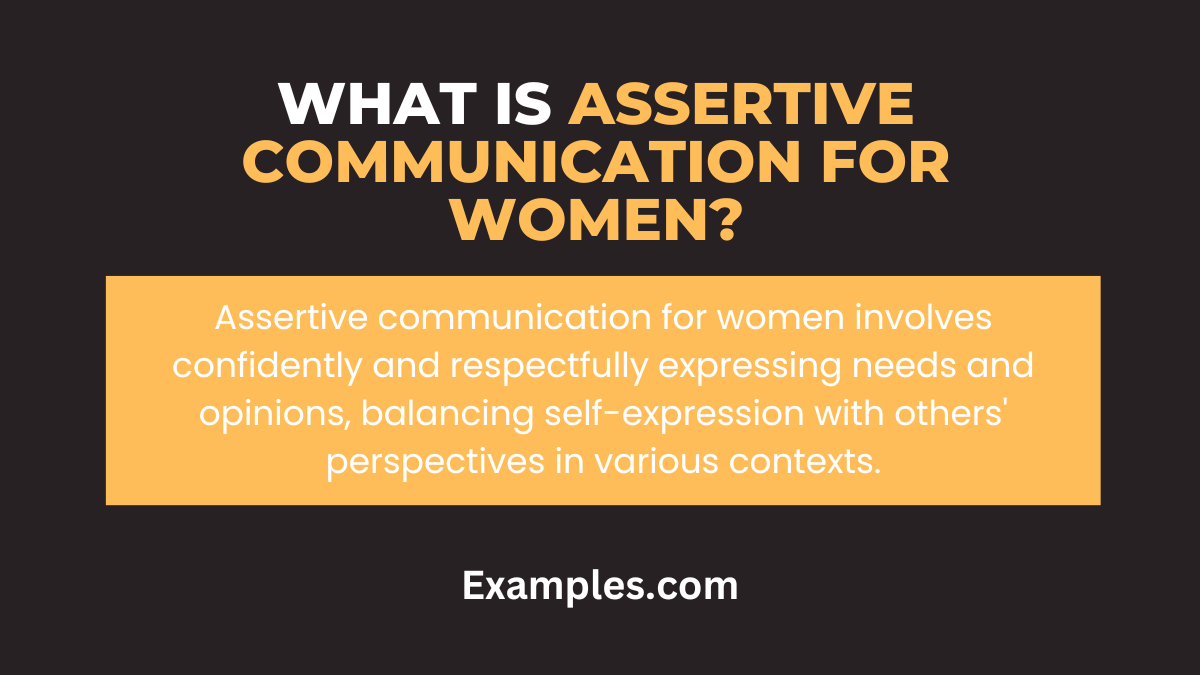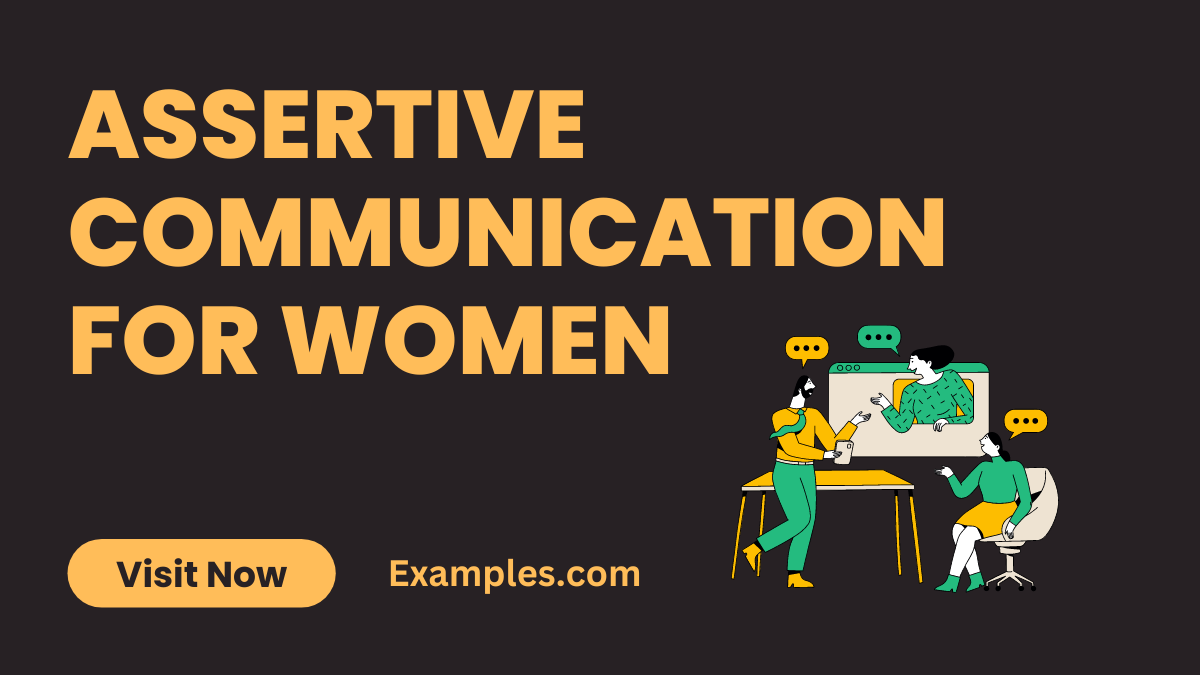19+ Assertive Communication for Women Examples
Assertive communication is crucial for women in both personal and professional realms, enhancing their oral communication and overall communication skills. This guide offers a collection of examples, showcasing how women can assert themselves effectively in various scenarios. From negotiating in the workplace to maintaining personal boundaries, these examples provide practical insights into effective communication and interpersonal skills. Ideal for women looking to strengthen their voice, this guide empowers them to communicate assertively, fostering respect and understanding in all interactions.
What is Assertive Communication for Women?

Assertive communication for women refers to expressing oneself clearly and confidently, without being passive or aggressive. It’s about stating needs and opinions respectfully, while also considering others’ viewpoints. This communication style is key for women in asserting their rights and opinions in personal and professional contexts, ensuring their voices are heard and respected.
20 Assertive Communication for Women Examples
Assertive communication is crucial for women in personal and professional settings. It involves expressing oneself confidently and respectfully, balancing self-expression with empathy. This guide offers 20 unique examples of assertive communication tailored for women, each accompanied by practical sentences. These examples demonstrate how to articulate needs, set boundaries, and engage in positive interactions, fostering empowerment and effective communication.
- Requesting Credit for Work: “I led the project and would appreciate acknowledgment for my contribution.” Expressing the need for recognition in the workplace.
- Declining Extra Workload: “While I value teamwork, I cannot take on additional tasks without compromising my current responsibilities.” Setting boundaries to maintain work-life balance.
- Negotiating Salary: “Based on my skills and experience, I believe a higher salary is justified.” Confidently discussing compensation.
- Addressing Interruptions: “I wasn’t finished speaking. Can I complete my thought?” Asserting the right to be heard.

- Responding to Unfair Criticism: “I’m open to feedback, but I prefer it to be constructive and respectful.” Handling criticism while maintaining dignity.
- Expressing Disagreement: “I see it differently and here’s why…” Sharing a contrasting viewpoint diplomatically.
- Asking for Help: “I’m struggling with this task and would appreciate your assistance.” Seeking support without hesitation.
- Turning Down Invitations Politely: “Thank you for the invite, but I’m unable to attend.” Declining offers gracefully.
- Voicing Concerns: “I’m concerned about this issue and would like to discuss potential solutions.” Proactively addressing problems.
- Advocating for Change: “This policy impacts us negatively. Let’s explore better options.” Championing improvements.
- Setting Personal Boundaries: “I’m not comfortable with this topic. Let’s focus on something else.” Establishing limits in conversations.
- Requesting Clarification: “Can you explain further? I want to ensure I understand correctly.” Seeking clarity to avoid misunderstandings.

- Giving Constructive Feedback: “Your work is great, but here’s a suggestion for improvement.” Balancing praise with helpful critique.
- Rejecting Unsolicited Advice: “I appreciate your input, but I’ve got this situation under control.” Maintaining autonomy in decision-making.
- Expressing Personal Needs: “I need some time for myself to recharge and perform my best.” Prioritizing self-care.
- Handling Condescension: “Please address me in a professional manner.” Demanding respect in interactions.
- Negotiating Work-Life Balance: “I need to adjust my schedule to better manage my work and personal life.” Advocating for a flexible work arrangement.
- Challenging Stereotypes: “Let’s not make assumptions based on gender. Everyone has unique strengths.” Breaking down gender biases.

- Asserting Opinions: “My opinion may differ, but it’s based on my experiences and knowledge.” Valuing one’s perspective.
- Standing Up Against Injustice: “This isn’t right, and we need to address it.” Speaking out against unfair practices.
Assertive Communication Skills for Women
- Understanding Assertiveness: Grasping the essence of assertive communication is the first step for women. It’s about expressing thoughts and needs clearly while respecting others. This skill is essential in both personal and professional spheres.
- Practicing Active Listening: Active listening is a core component of assertive communication. For women, it means not just hearing but understanding and acknowledging others’ viewpoints, which enhances mutual respect and understanding.
- Effective Use of Body Language: Non-verbal cues play a significant role in assertive communication. Women can convey confidence through eye contact, posture, and gestures, complementing their verbal messages.
- Expressing Needs Clearly: In assertive communication, women should articulate their needs and desires unambiguously. This involves using ‘I’ statements to own their messages and avoid misunderstandings.
- Setting Boundaries: Assertive communication for women includes the ability to set and maintain healthy boundaries. It’s about saying no when necessary, without feeling guilty or offering excessive explanations.
- Handling Conflict: Conflict resolution is a crucial aspect of assertive communication. Women can address disagreements constructively, focusing on solutions rather than personal attacks.
- Giving and Receiving Feedback: Mastering assertive communication involves giving constructive feedback and receiving critiques gracefully. This skill is vital for personal growth and building strong relationships.
- Negotiation Skills: In assertive communication, negotiation is not about winning; it’s about finding mutually beneficial solutions. Women should aim for win-win outcomes, maintaining their stance while being open to others’ ideas.
- Self-Confidence: Confidence underpins assertive communication. Women should believe in their value and rights, which is reflected in their communication style.
- Continual Learning and Adaptation: The landscape of assertive communication is ever-evolving. Women should continually hone these skills, adapting to different situations and people.
Assertive Communication for Women in Training
- Role-Playing Scenarios: Training in assertive communication often involves role-playing. This helps women practice real-life scenarios, from workplace negotiations to personal conversations.
- Feedback Sessions: In assertive communication training, constructive feedback is vital. It allows women to understand their strengths and areas for improvement in their communication style.
- Understanding Emotional Intelligence: Emotional intelligence is a key component of assertive communication training. It involves recognizing one’s emotions and those of others to communicate more effectively.
- Developing a Strong Voice: Training should focus on helping women develop a strong, clear voice, a crucial aspect of assertive communication. It’s not just about volume, but clarity and conviction.
- Learning Assertive Language: Assertive communication training for women includes using assertive language. This involves choosing words that are direct yet respectful, avoiding passive or aggressive tones.
- Stress Management Techniques: Managing stress is essential in assertive communication training. Women learn to remain calm and composed, even in challenging conversations.
- Empathy and Understanding: Assertive communication is not just about being heard but also about understanding others. Training should emphasize empathy, an essential skill for effective communication.
- Cultural Sensitivity: In today’s global environment, assertive communication training must include cultural sensitivity. Understanding diverse perspectives is key to assertive and respectful communication.
- Assertiveness in Digital Communication: With the rise of remote work, assertive communication training should cover digital platforms. This involves email etiquette, virtual meeting dynamics, and more.
- Regular Practice and Reflection: Effective assertive communication training for women requires regular practice and reflection. It’s about continuous improvement and adapting to various communication challenges.
Types of Assertive Communication for Women
- Positive Assertion: This type of assertive communication involves expressing positive feelings and gratitude. It’s about acknowledging good work, sharing compliments, and creating a positive atmosphere.
- Empathic Assertion: In assertive communication, empathic assertion is showing understanding and empathy towards another person’s situation before expressing one’s own needs or concerns.
- Escalating Assertion: This approach in assertive communication is used when initial assertive statements are ignored. It involves progressively firmer (yet respectful) communication until the issue is addressed.
- ‘I’ Statements: A cornerstone of assertive communication is using ‘I’ statements. This helps women express their feelings and thoughts without blaming or accusing others.
- Broken Record Technique: This assertive communication technique involves repeating a point calmly and persistently until it is acknowledged. It’s effective in ensuring a message is heard without escalating to aggression.
- Fogging: In assertive communication, fogging means agreeing with any truth in criticism without becoming defensive. It allows women to acknowledge the point without escalating the conflict.
- Negative Inquiry: This assertive communication strategy involves seeking further clarification on negative comments or criticisms, which can lead to more constructive dialogue.
- Negative Assertion: In assertive communication, negative assertion means accepting your errors or faults without being defensive. It’s about taking responsibility and showing a willingness to improve.
- Expressive Assertion: This type of assertive communication involves expressing one’s personal rights or beliefs without violating another’s rights. It’s about being firm yet fair.
- Consequence Assertion: Consequence assertion, a form of assertive communication, involves explaining the consequences of actions, helping others understand the impact of their behavior.
Mastering assertive communication is vital for women in all aspects of life. This guide provides practical examples and strategies to effectively express oneself while respecting others. Embracing these skills fosters confidence, enhances relationships, and empowers women to navigate diverse scenarios with clarity and strength, ultimately leading to personal and professional growth.
The article on “Assertive Communication for Women” from examples.com provides a comprehensive understanding of how women can use assertive communication in various scenarios to enhance their personal and professional lives. It highlights the importance of expressing oneself clearly and confidently, balancing self-expression with empathy, and respecting others’ viewpoints. The guide includes 20 practical examples of assertive communication, skills necessary for assertiveness, training methods, and different types of assertive communication tailored for women.
To conclude this informative guide, it’s essential to reiterate the transformative power of assertive communication in women’s lives. This communication style is not just a professional tool but a vital aspect of personal growth and empowerment. By adopting assertive communication, women can navigate complex social and professional landscapes with greater confidence and clarity. For additional resources and training materials, visiting websites like Toastmasters International can offer valuable insights into improving public speaking and communication skills. Similarly, exploring the resources available at MindTools, which provides extensive materials on leadership and communication, can further enhance understanding and application of assertive communication techniques. These external links offer a wealth of knowledge for continuous learning and improvement in assertive communication.



